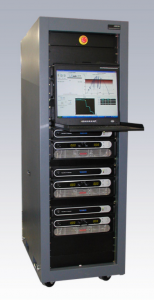Solar Array Simulation Enables Better PV Inverter Testing for Manufacturers
 To accurately simulate solar arrays, you should use a system specifically designed for this task, such as the Elgar TerraSAS.
To accurately simulate solar arrays, you should use a system specifically designed for this task, such as the Elgar TerraSAS.
As a result of improvements in solar array technology and government incentives for implementing green technologies, solar systems are becoming increasingly cost-effective for residential and commercial use. The onus is now on solar inverter manufacturers to keep up with the market’s rapidly accelerating requirements. The challenges include keeping up with developments in solar array technology and evaluating solar panel array performance parameters.
Historically, inverter manufactures have used the actual solar arrays when testing their products. This method is less than optimal, though.
Solar arrays operate in an uncontrolled environment. Their output is highly dependent on a range of conditions including the intensity of the sunlight (full sun vs. cloudy conditions), ambient temperature, external shading effects (from tree branches or chimneys), dust, bird droppings and other factors. All of these elements affect the capacity of the solar array to produce power.
To ensure that an inverter design will transfer the maximum amount of power from a solar array to the grid, that is to say that it's operating at or near the maximum power point (MPP), it must be tested under a wide variety of conditions. It is important to not only create a wide variety of input power conditions, but these conditions must also be repeatable for design and production testing. This is really impossible using actual solar arrays.
To properly test photovoltaic (PV) inverters—both in development as well and production—you need a power source, such as the Elgar TerraSAS, that can reliably simulate actual solar array performance. TerraSAS uses the National Renewable Energy Laboratory's (NREL) Solar Advisor Model (SAM) database, which includes key parameters such as Voc, Isc, Vmpp at 24C and standard 1000 W/m2 isolation, to simulate hundreds of commercially available PV products. The SAM provides powerful tools to help designers predict system performance for virtually any fill factor or solar material. As a result, you can use the TerraSAS solar array simulator to perform realistic, dynamic, interactive PV inverter tests.
Realistic simulation
Whatever solar array simulator you use, the simulation must be as realistic as possible. For example, many PV inverters generate AC ripple on the DC connected to the photovoltaic array. For single-phase inverters, the frequency of this ripple is twice the line frequency (120 Hz for US models). An increasing number of inverters (and virtually all micro-inverters) accurately measure amplitude and phase of the ripple voltage and current to quickly track the MPP of the array.
This approach allows the inverter to track the MPP at a much higher speed when compared to conventional dithering techniques (also called perturb and observe). Faster tracking of the MPP results in a much higher overall efficiency in cloudy conditions, where the irradiance is constantly changing. It is likely that all solar inverters will use this approach in the near future, since end users are very sensitive to the overall efficiency of their solar energy installations.
The simulator’s power supplies must not suppress this ripple as a function of their regulation loop. To perform the most effective test, the solar array simulator must be capable of reproducing the voltage / current behavior of a solar array even in the presence of this ripple.
This is just one of the parameters that you must consider when selecting a solar array simulator. For more information on solar array simulators and what to look for when choosing them, contact AMETEK Programmable Power: e-mail sales.ppd@ametek.com or call 858-458-0223.
